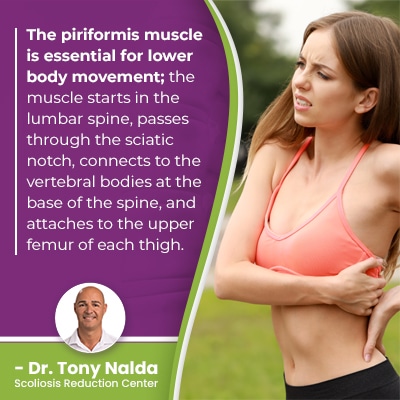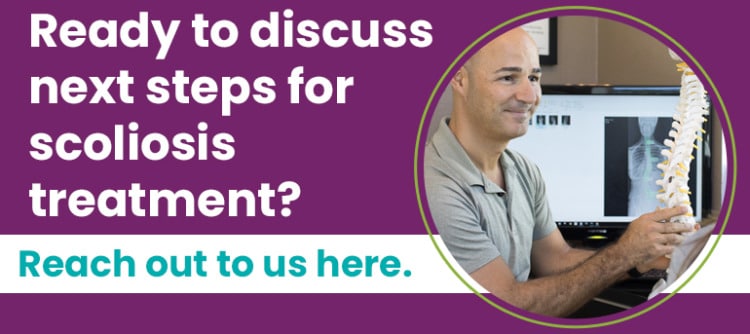Piriformis Syndrome: Causes, Symptoms, and Treatments

Nerves need room to function optimally, and if the piriformis muscle spasms, it can compress and irritate nearby nerves, including the sciatic nerve. As the largest nerve in the body, sciatic nerve compression can cause a number of symptoms felt throughout the lower body.
The piriformis muscle starts in the lumbar spine and connects to the femur of each thigh; it passes through the sciatic notch, and its close proximity to the sciatic nerves can become problematic if muscle spasms develop as part of piriformis syndrome.
If the piriformis muscle is strained and spasms, it can directly affect the sciatic nerve.
Table of Contents
The Piriformis Muscle
 The piriformis muscle is essential for lower body movement; the muscle starts in the lumbar spine, passes through the sciatic notch, connects to the vertebral bodies at the base of the spine, and attaches to the upper femur of each thigh.
The piriformis muscle is essential for lower body movement; the muscle starts in the lumbar spine, passes through the sciatic notch, connects to the vertebral bodies at the base of the spine, and attaches to the upper femur of each thigh.
The piriformis muscle externally rotates the thigh and upper leg muscles so is essential for lower body movement and function.
When the hip extends (straightens) or bends (flexion), the piriformis muscle laterally rotates and abducts the femur, so the mobility of the legs depends on the health and function of the muscle.
The sciatic notch is found in the pelvis and is an opening through which the sciatic nerve extends into the leg, so the piriformis muscle and sciatic nerve are adjacent at this location, so the health of the piriformis muscle can directly affect the sciatic nerve.
If the muscle spasms, is irritated, or damaged, it can press on the sciatic nerve and cause the nerve to become irritated and/or inflamed.
If a nerve has less space to function within, its function and health can be disrupted.
Sciatic nerve compression can cause a number of symptoms and is also capable of disrupting lower body movement and function.
The Sciatic Nerve
Sciatica isn't a condition itself, although many think it is; the term sciatica references pain felt anywhere along the nerve's pathway but doesn't indicate the cause.
The sciatic nerve is the largest in the body and as a mixed nerve containing both sensory and motor fibers, it's involved in sensation and movement.
The sciatic nerve starts in the lumbar spine and extends down the back of the hip, pelvis, buttock, and into the leg and foot.
In most cases of sciatica, symptoms are felt down the left side, but it can also involve the right, and in rare cases, symptoms can be felt down both sides of the lower body.
If the sciatic nerve is exposed to uneven pressure, it can become inflamed, irritated, compressed, and/or impinged, and symptoms can be felt anywhere along the nerve's extensive pathway.
In some cases of sciatic nerve pain, symptoms will abate on their own, but if they persist, assessment and treatment is needed.
Sciatic nerve pain can involve flare ups during which time symptoms intensify before abating, and if left untreated and the sciatic nerve becomes damaged, pain can become chronic and debilitating.
Neuropathy can be difficult to reverse, so a treatment goal is to improve nerve health before any type of lasting damage occurs.
Now that we've explored the nature of the piriformis muscle and the sciatic nerve, let's discuss what causes piriformis syndrome to develop.
Piriformis Syndrome Causes
In order for any type of long-term pain relief, a condition's underlying cause has to be determined and addressed.
While pain medications can help with pain relief, this solution is only short-term, and addressing symptoms of a condition isn't the same as addressing their underlying cause: the condition itself.
Most cases of piriformis syndrome are idiopathic, meaning not clearly associated with a single-known cause, but some known causes of piriformis syndrome include:
- Trauma/injury
- Atypical development of the sciatic nerve or piriformis muscle
- Atypical location of the sciatic nerve or piriformis muscle
- Leg length discrepancy (LLD)
- Sitting for long periods of time
- Muscle strain from overuse
- Conditions like scoliosis that cause a misaligned spine
- Foot conditions
Proactive treatment is the best method for long-term symptom relief.
Symptoms of Piriformis Syndrome
Symptoms of piriformis syndrome can vary from person to person, depending on cause and severity.
 If the piriformis muscle spasms, is irritated, and/or inflamed and compresses the sciatic nerve where it passes through the notch and exits the pelvis, various levels of pain can develop.
If the piriformis muscle spasms, is irritated, and/or inflamed and compresses the sciatic nerve where it passes through the notch and exits the pelvis, various levels of pain can develop.
Pain is commonly felt in the lower back, hip, leg, and into the foot. Nerves are like branches of a tree projecting into different areas, so even if the sciatic nerve is compressed at the base of the spine, its effects can also be felt in the feet.
Symptoms of piriformis syndrome can also develop if there is less room between the sciatic nerve and the muscle.
While the cause is unclear, piriformis syndrome more commonly affects females.
Symptoms of piriformis syndrome can include:
- Hip pain during movement
- Pain felt throughout the lower body
- A stiff hip that's less mobile
- Difficult sitting for long periods of time
- Muscle spasms
Treatment options can provide relief but need to be individualized.
Piriformis Syndrome Treatment Options
The underlying cause of piriformis syndrome symptoms is the health of the piriformis muscle and its proximity to the sciatic nerve.
Conservative treatment options are nonsurgical, and this is the approach patients of the Scoliosis Reduction Center® benefit from.
Pain medications and muscle relaxants can be prescribed for short-term pain relief, but conservative treatment has the goal of improving the health of the piriformis muscle.
Heat therapy can help reduce inflammation and pain. If an injury or trauma is the cause, the injury has to be addressed, and if a condition like leg length discrepancy or scoliosis is the cause, it has to be the focus of treatment.
If unequal leg length is structural and is causing piriformis syndrome, heel lifts can help, and if a condition like scoliosis has caused an unnatural spinal curve that affects the health of the piriformis muscle, the spine's alignment has to be improved to reduce pressure and compression of the spine and its surrounding muscles and nerves.
Spinal conditions that affect the lumbar spine are most closely associated with piriformis syndrome as this is where the piriformis muscle and the sciatic nerve start.
Chiropractic care can work towards realigning the spine and reducing pressure on the piriformis muscle and the sciatic nerve, and physical therapy can help strengthen the hip abductors and improve the health and strength of the piriformis muscle.
Improvements to posture and gait can also help improve joint mobility and regular stretching exercises can help keep the piriformis muscle loose and flexible.
Conclusion
As the piriformis muscle is essential to lower body movement, its health is important.
Because of the close proximity to the sciatic nerve, if the piriformis muscle spasms, it can cause sciatic nerve compression and sciatic pain.
As the sciatic nerve is involved in both sensation and movement, sciatic nerve compression can also cause a number of symptoms felt throughout the lower body.
Symptoms of piriformis syndrome can include lower back pain, hip pain, leg and foot pain, radiating pain, muscle spasms, difficulty sitting, less mobility in the hip, and disruptions to movement.
Common causes of piriformis syndrome include injury, atypical placement of the piriformis muscle and sciatic nerve (too close together), and conditions that cause compression of the spine and its surroundings like scoliosis.
The best way to minimize the potential effects of piriformis syndrome is to treat it proactively, and the first step is determining the underlying cause of the muscle tightness and spasms.
Here at the Scoliosis Reduction Center®, the approach is conservative and proactive. The goal of treatment is always long-term results, and chiropractic care can work towards improving the spine's alignment to reduce compression of the spine's surroundings, including the piriformis muscle and the sciatic nerve.
Physical therapy can help improve the health of the piriformis muscle by strengthening it and working towards maintaining its position and flexibility, and stretching exercises can also help with pain and mobility.
Postural awareness and changes to gait can also help maintain the body's overall symmetry, reducing uneven forces on its individual parts.
Dr. Tony Nalda
DOCTOR OF CHIROPRACTIC
After receiving an undergraduate degree in psychology and his Doctorate of Chiropractic from Life University, Dr. Nalda settled in Celebration, Florida and proceeded to build one of Central Florida’s most successful chiropractic clinics.
His experience with patients suffering from scoliosis, and the confusion and frustration they faced, led him to seek a specialty in scoliosis care. In 2006 he completed his Intensive Care Certification from CLEAR Institute, a leading scoliosis educational and certification center.
About Dr. Tony Nalda
 Ready to explore scoliosis treatment? Contact Us Now
Ready to explore scoliosis treatment? Contact Us Now





